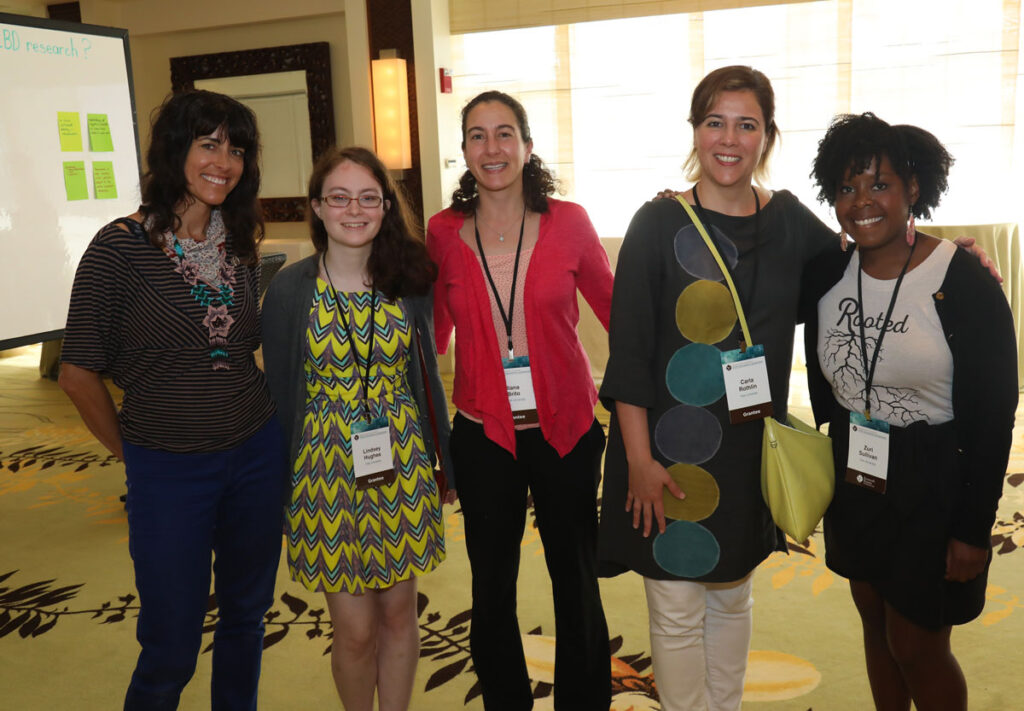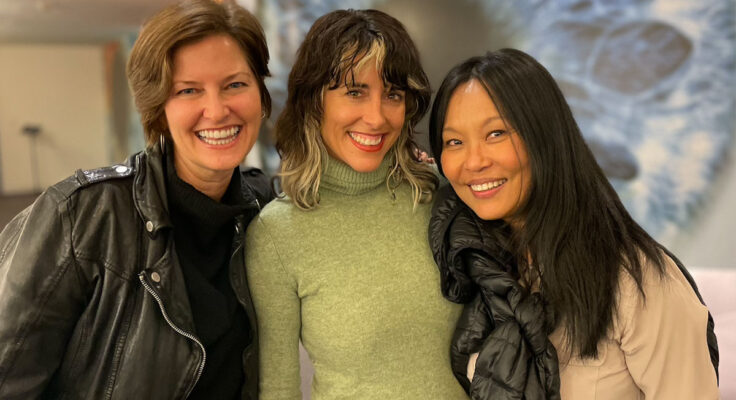The Kenneth Rainin Foundation’s Board of Directors plays an essential role in furthering our mission. In this new series, we hope our grantees and partners can become acquainted with how our Board members’ experiences and perspectives contribute to our work.
Our first profile features Rivkah Beth Medow who joined our Board of Directors in 2011. Rivkah is an Emmy award-winning filmmaker who’s known for working collaboratively on character-driven films that deepen connections and build community. She’s co-led film projects with national nonprofits including Ella Baker Center for Human Rights, The Pachamama Alliance and The National Coalition for the Homeless. She also co-created a student-driven media literacy and production program in the Oakland Unified School District. Following are highlights from our conversation with her.
Tell us about the early years as a Rainin Foundation Board member.
When I joined the Board in 2011, there were three of us; we were small and start up. There was one employee and we awarded $1 million among all the giving areas. Jen was mourning the loss of her father, she was transitioning into this role as CEO and we were all learning about philanthropy as a sector together. As an artist, I had always been the one seeking grants. The opportunity to experience the world from a grantmaker perspective exposed me to an ecosystem of philanthropy that I wasn’t aware of as a grant seeker. We also knew that by 2014, there would be a major transfer of assets to the Foundation, followed by another in 2016. We had to be prepared to level up responsibly with our giving, which was both daunting and incredibly exciting.
“The opportunity to experience the world from a grantmaker perspective exposed me to an ecosystem of philanthropy that I wasn’t aware of as a grant seeker.”
Jen watched her father innovate through his businesses and helped our Board integrate innovation as a foundational value. Our naiveté about philanthropy allowed us to dream big. Not knowing the rules of philanthropy meant we weren’t confined by them. And our financial resources gave us access to experts. The creation of the Community Arts Stabilization Trust (CAST) in 2013 illustrates this best. We were in a generative mode building the Foundation and at the same time, artists and nonprofits were leaving the Bay Area because they couldn’t afford to stay. I had just purchased my home and the ability to know and plan for my monthly home expenses coupled with the tax breaks as a homeowner was transformational. So, we asked, “What if all nonprofits and artists could buy their buildings? Or at least sign long leases so they could project their rent costs 5, 10, 20 years into the future?” We met with the Northern California Community Loan Fund (now Community Vision) and other organizations and partners that educated us. We also listened carefully to each other, and to Shelley Trott who was leading the Arts program at that time.
It was empowering to bring our creativity and cook up an idea with roots in a real need, connect with experts, become more knowledgeable and ultimately collaborate with others to build CAST, a solution that has helped transform access to space for nonprofits in the Bay Area and serves as a national model.
How do your background and the Foundation’s values—interdependence, creativity and equity—shape your leadership?
Every film that gets made is a sort of miracle of interdependence—anyone who’s seen a credit roll can attest to that! As a filmmaker, I believe in bringing together brilliant crews and trusting them to do inspired work with me. They know their craft best and I have no interest in micromanaging them. Rather, I want to be in a generative process with them, which requires humility and trust, and recognizing our interdependence contributes to flow on set and a better film. I bring a similar mindset to my leadership as a Board member. I see our staff, grantees and communities as the experts in the work of the Foundation. I seek opportunities to listen to their assessments and ideas, which helps me put aside preconceptions about what I might think would be helpful, learn more about our grantees’ contexts, build stronger relationships and become a better steward of the Rainin Foundation’s resources.
“I see our staff, grantees and communities as the experts in the work of the Foundation.”
The way I’ve been viewing creativity lately is through the lens of conflict. As in, have we built the kinds of resilient relationships that can withstand creative conflict with one another? In vérité filmmaking, which is often what I do, you have to make decisions quickly, trust your crew to know their jobs and have solid judgement—which is all about interdependence. When I articulate my point of view clearly, listen openly to my collaborators’ response and invite them to challenge me, that’s when we can get somewhere better, somewhere neither of us could arrive at alone. When we build resilient relationships with our collaborators, we can debate toward a deeper understanding of whatever issues or ideas we’re exploring. We know that we’re having conflict toward understanding, instead of ego or winning.
At the Rainin Foundation we view equity as a journey and provide structured support to Board and staff to facilitate personal growth in this arena. I trace my own conscious journey around equity to just after college when I volunteered with the Peace and Justice Center in Burlington, Vermont. There was an older, Black civil rights activist named John Tucker there and I became his assistant. He was brilliant and generous. He did what we now call DEI (Diversity, Equity and Inclusion) trainings for government and businesses, but this was the year 2000 and they were still called “tolerance trainings.” I remember a meeting with the governor of Vermont and his staff, most of whom were white (as am I), about funding these trainings. When Mr. Tucker introduced me and told everyone I’d be taking notes for him, the room shifted. It felt like Mr. Tucker’s status was elevated because he had a young, white assistant and on the drive back from Montpelier, Mr. Tucker and I talked about race, positionality, politics of representation and gender power dynamics we experienced in that room. Though we didn’t use the phrase “white supremacy” then, that’s what he was teaching me to deconstruct.
“I believe that good leaders are excellent listeners, and so in my own leadership, I work to cultivate equitable spaces for people in different roles to speak freely.”
My work on the Rainin Foundation’s Board has given me an opportunity to reflect on the power that Board members hold in the eyes of staff. It’s taken a moment to recognize the weight of this, first because I still identify as a working artist and grant seeker in my day job of filmmaking, and next because we just had one employee at the Foundation when I came onto the Board. I believe that good leaders are excellent listeners, and so in my own leadership, I work to cultivate equitable spaces for people in different roles to speak freely.
What has been different about your Board experience than you anticipated?

While I understand that disrupting systemic and structural equity issues is challenging and long-term work, I’ve been shocked at how difficult it’s been to make faster progress in some of our work even with considerable financial and relational investments over the past 11 years. It’s affirming to see how the Foundation uses data and research to identify inequities, inform our responses and prioritize solutions. While we’re seeing bright spots in our Arts, Education and Health grantmaking, specifically around our arts ecosystem here in the Bay Area and increasing diversity of investigators in our Health program, racially determined outcomes in early education are proving a much more entrenched problem than I ever imagined.
Oakland has been my home for the past 22 years—I send my kids to public schools here—so we’re talking about kids in my community, my chosen family, friends’ and neighbors’ Black and Brown kids, so the slow pace of progress can feel devastating. I’m grateful that our Education program considers best in class, data-driven research, understands the social determinants of educational outcomes, includes the community of parents in decision-making around grants and realigns our strategy with partners and fellow grantmakers to achieve our goal of all Oakland students entering kindergarten ready to read at or above grade level by the end of third grade.
How do you approach your discretionary grantmaking?
The ability to give discretionary grants is one of the extraordinary gifts of being on the Board. Coming from some thrifty Midwestern roots, I’m especially interested if my discretionary grant can be leveraged with other grants and to make lasting change. My giving interests center around equity, art and the environment and I’ll often seek a confluence of those three areas.
“Service, gratitude and a solid sense of humor are the best keys I’ve found to doing this work.”
I’ve given discretionary grants that support landback movements of native tribes, mindfulness education in historically underserved schools, violence prevention work in Oakland and a climate change storytelling playbook for film and TV writers. One of my more creative grants grew out of an experience I had at a 2014 exhibition called The Possible, at the Berkeley Art Museum (BAM). It activated the museum in a way that I hadn’t seen before. It was so multidisciplinary and multicultural, a real celebration. I talked with the Museum’s Director, Larry Rinder. We liked the idea of a similar engagement with the public when the Museum reopened in its new space, so I made a three-year commitment of $150K to make it possible. We also met with other funders to get people excited about incorporating this as an ongoing activity at the Museum.
The result was Way Bay 2 in 2018. Larry worked again with the artist David Wilson to transform the new space. They engaged nearly two hundred Bay Area artists and collectives over the year. There was a Black Life series with rotating curators, artists from the San Quentin Prison Studio, a fabric-making event with the Chulita Vinyl Club and Creative Growth. Even my nearly 100-year-old dance teacher Anna Halprin did workshops! It was tremendous. And trailblazing! BAM continues this kind of programming and other museums around the country are increasingly incorporating these kinds of activations now as well.
What else do you want people to know?
That’s a massive question. How about that service, gratitude and a solid sense of humor are the best keys I’ve found to doing this work.

